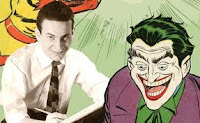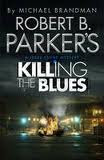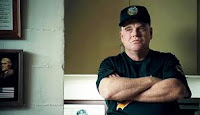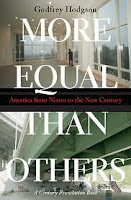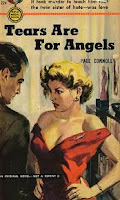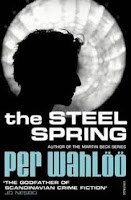 After discovering Maj Sjowall and Per Wahloo's Martin Beck in the early Seventies in Sweden, I remember searching around for Per Wahloo's early novels, and finding all of them except The Steel Spring (1968). In fact, I had forgotten about the book, until Vintage's reissue of it along with the other Chief Inspector Jensen novel, Murder On The 31st Floor, in new translations by Sarah Death, whose work here seems to catch the bleakness perfectly.
After discovering Maj Sjowall and Per Wahloo's Martin Beck in the early Seventies in Sweden, I remember searching around for Per Wahloo's early novels, and finding all of them except The Steel Spring (1968). In fact, I had forgotten about the book, until Vintage's reissue of it along with the other Chief Inspector Jensen novel, Murder On The 31st Floor, in new translations by Sarah Death, whose work here seems to catch the bleakness perfectly.It's fascinating to read Wahloo in retrospect. The Steel Spring is a dystopian sf novel, in which Jensen, having gone abroad for a liver transplant, receives a message from his government telling him to return home. He soon discovers that his country is closed off to the outside world, but his doggedness gets him back home, where he finds an epidemic has struck, and his familiar surroundings are almost deserted.
Wahloo's concerns are the failure of social democracy, with a specific eye toward the way social improvement leads to social control, and democracy edges into totalitarianism. The urge to control is what has led to the epidemic, a case of society destroying itself from within. That the government under which this tragedy has happened is a nominal coalition makes the story shiveringly relevant to today's Britain, if not as much Sweden. The nameless country in which Jensen works seems to be a mix of Sweden with some proto-Iron Curtain eastern European state, sort of Albania or Romania thrown in.
Jensen is the perfect protagonist for such a setting, and in him it's easy to discern the prototype Beck. He has no personal life, appears to have no opinions or preferences, very little individual feeling, apart from doing his job to the best of his ability, which implies a sort of blind faith in the laws, the social contract, he enforces.
That was always the main conflict in the Beck books: the contrast between the world the policeman is protecting, and the laws he is enforcing—the way they are applied selectively, or not at all, depending on circumstances beyond his control. If The Steel Spring has a flaw, it's that most of the realisations seem to come from Wahloo,
 because although they are presented via Jensen, Jensen doesn't seem to share the criticisms which are obviously implied. Or maybe it's because he can't see them as criticisms, whereas we can. Which is the mark of good dystopian fiction. Wahloo's solo work deserves to be considered in the same context as Zamyatin, Capek, Orwell, or Durrenmatt...high praise indeed. I will probably revisit Murder On The 31st Floor soon, and if you haven't got to the Martin Beck books, please start now—and be aware I wrote the introduction to the sixth volume in the Harper Perennial reissues, Murder At The Savoy.
because although they are presented via Jensen, Jensen doesn't seem to share the criticisms which are obviously implied. Or maybe it's because he can't see them as criticisms, whereas we can. Which is the mark of good dystopian fiction. Wahloo's solo work deserves to be considered in the same context as Zamyatin, Capek, Orwell, or Durrenmatt...high praise indeed. I will probably revisit Murder On The 31st Floor soon, and if you haven't got to the Martin Beck books, please start now—and be aware I wrote the introduction to the sixth volume in the Harper Perennial reissues, Murder At The Savoy.The Steel Spring by Per Wahloo
Vintage £7.99 ISBN 9780099554752
This review will also appear at Crime Time (www.crimetime.co.uk)
